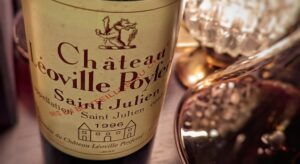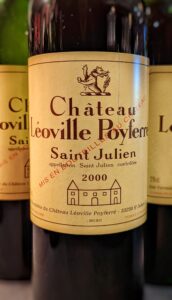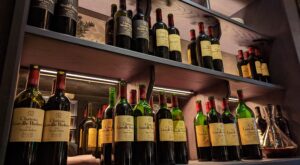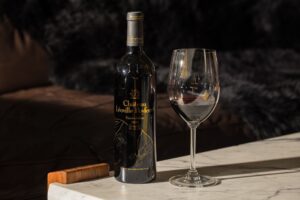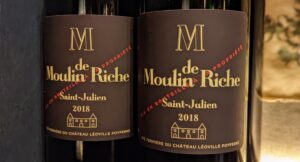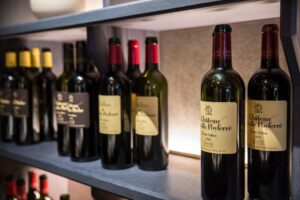On the Left Bank of the Bordeaux wine region live the prominent First Growths of the 1855 classification, when producers like Lafite and Latour were carved into history as the fine wines that all others would aspire to reach. Even with the anointing of greatness over a century ago, these top Grand Cru Classé wines still had to make significant improvements when their superlative quality was questioned during particular decades. Still, today, they are unquestionably considered the top of the Left Bank red wines that consistently deliver year in and year out. But the châteaux that are one notch down, the Second Growths, have a handful of producers that can reach First Growth quality in some years and they are given the unofficial name “Super Second,” despite never coming close to First Growth prices even in their best years.
When it comes to the Saint-Julien sub-region (a.k.a. appellation) in this area, located below the appellation of Pauillac, where Lafite and Latour are located, there is one château that always comes to mind when thinking of a “Super Second” and that is none other than Léoville-Las Cases. Yet a sibling seems to always follow behind Las Cases, either not taken as seriously in the past or not thought of at all, and that is Léoville-Poyferré. They just recently celebrated their 100th anniversary of the Cuvelier family running the estate, which is a key factor in majorly raising the quality to such a point that some would argue that Poyferré is performing at the same level as Las Cases in some vintages, although it will typically be priced 40% less.
Léoville-Poyferré
One might ask if Poyferré and Las Cases are somehow related and that wouldn’t be a foolish question as they were both part of one larger estate called Léoville. And back in the mid-1800s, Léoville was considered at the forefront of vineyard management and divided in 1840 using the appendices of Poyferré and Las Cases to represent the new owners of each property. To make things even more complicated, the land would be further separated into three different estates: Léoville-Poyferré, Léoville-Las Cases and Léoville Barton. All three would be seen as equals once the 1855 classification was designated, awarding the eternal ranking of Second Growth yet along the way, Las Cases started to gain a more prestigious name, hence commanding higher prices.
When addressing the modern history of Léoville-Poyferré, there has been no greater influence than the Cuvelier family who bought the property in 1920. Perhaps part of the issue, initially, that Poyferré couldn’t distinguish itself earlier at the beginning of the Cuvelier era is because the family had the Léoville-Las Cases owner also manage their property. That all changed when Didier Cuvelier took over Léoville-Poyferré in 1979 and learned about wine from one of the greats, Emile Peynaud, the forefather of modern winemaking. Under Didier’s guidance, the winery was redone with state-of-the-art equipment and a replanting program that spanned two decades, increasing the percentages of Cabernet Sauvignon in the vineyards and adding the first plantings of Petit Verdot, was implemented. As time went on, to those in the know, Léoville-Poyferré became one of the most exciting estates in Saint-Julien; it was the dark horse that all of a sudden started sprinting with a fierce velocity.
Didier retired a few years ago and handed the reigns to his cousin, Sara Lecompte Cuvelier, who celebrated Didier’s achievements recently with a vertical tasting celebrating the 2020 Léoville-Poyferré, the 100th vintage since the Cuvelier family has taken ownership.
1996 Vintage
The vertical in New York City showcased a handful of their best vintages in recent times, some being an outstanding vintage for the Left Bank as a whole and others a shining moment for only certain châteaux, including Léoville-Poyferré. First, they displayed the 2018 Léoville-Poyferré, which is already impressing top critics with Jeb Dunnuck giving it 100 points and famous British wine critic Jancis Robinson giving it 19 out of 20 points; and anyone familiar with Jancis Robinson scoring knows she rarely gives out a high score. Also, they gave a preview of their 2020 vintage, which is bottled in a stunning anniversary bottle showcasing their vineyards.
Then the enchanting 2016, the lesser-known 2014, the superstar vintages of 2009, 2005 and 2000, and finally, the controversial 1996, were all in the lineup. Why is 1996 controversial? Many top Bordeaux wine collectors have differing views on this vintage as it has had more ups and downs than any other outstanding year and so some question whether it is on the same greatness level as 2000.
From the first bottlings, the 1996s were considered excellent on the Left Bank, especially more Cabernet Sauvignon-dominated blends and so as one may guess, Léoville-Poyferré made a sensational wine. There was a lot of structure and power and the great ones, such as Poyferré, would make outstanding old bones, 30 years and beyond. Yet many of these wines have had a rollercoaster ride of varying stages, one stage showing its superiority and at other times, the same bottle will take a sharp turn and seem to be at the end of its life way too early without the tannins ever completely integrating.
But 1996 is an ideal vintage to show during this momentous occasion, not only because it was a vintage that brought a lot of attention to Léoville-Poyferré but it also represents the rocky journey of this estate that was always cut out for greatness but because of some missteps, it initially lost that momentum reinforcing that greatness in the minds of Bordeaux wine critics and collectors. In a way, no matter how stellar the bottling, there is always that first reaction to assume that Las Cases is better than Poyferré, as it is like that story about the sociological experiment, that may or may not be true, where researchers sprayed monkeys with ice-cold water every time they tried to climb up a ladder to get bananas; as they rotated new monkeys into the group and older ones out, through time the more seasoned monkeys kept the newer ones from trying to climb up the ladder. Eventually, none of the monkeys in the group have ever attempted to climb the ladder and they don’t know exactly why they shouldn’t as none of those had ever been sprayed with the ice-cold water – they only knew that they should never try it.
That same behavior can be seen in humans, as no one wants to make a fool out of themselves by saying in any particular vintage that they prefer Poyferré over Las Cases, as it has been passed down that Las Cases is at the top of the pecking order when it comes to the Léoville wines. Indeed, no one can argue with Las Cases’ stellar quality in many vintages; the idea of Poyferré always defaulting to an afterthought is the issue. Many have assigned it to a lesser position than what it deserves. The Cuvelier family, especially Didier Cuvelier, never gave up on the property, no matter how unfair the situation might have seemed.
Their 1996, has had the same path – at first impressing the taster with its sensational qualities but then it went through awkward stages, even indicating at times that it might be at the end of its life after only two decades. But today, it is awe-inspiring and those who didn’t give up on it have been rewarded. And the newest 2018 Poyferré suggests that it has much more to give than its fans could have imagined. And now, Sara Lecompte Cuvelier has taken the baton to bring Bordeaux lovers into the next era of Léoville-Poyferré.
***Link to original Forbes article: https://www.forbes.com/sites/cathrinetodd/2022/12/15/top-wine-vintages-explored-to-celebrate-2nd-growth-bordeaux-producers-100th-anniversary/
2020 Château Léoville-Poyferré, Saint-Julien, Bordeaux, France: 64% Cabernet Sauvignon, 31% Merlot, 3% Cabernet Franc and 2% Petit Verdot. The preview of the 100th Anniversary bottling has hit the market as a pre-sale that will arrive in the fall of 2023. Aromatic nose of purple flowers and blueberry pie with spicy notes of nutmeg and cinnamon with a stony minerality that has a plush body with cassis flavors with an overall freshness, finely chiseled tannins and long, expressive finish with an elegant precision.
Four different wines from the Léoville-Poyferré estate were shown for their recent 2018 vintage:
2018 Château Moulin Riche, Saint-Julien, Bordeaux, France: 57% Cabernet Sauvignon, 31% Merlot and 12% Petit Verdot. The Moulin Riche is from the more western part of the Léoville-Poyferré estate, slightly further from the river, where most of their Petit Verdot vines are planted. Approachable flavors with blackberry jam and blueberry scones with a hint of fresh tobacco that has a silky texture.
2018 M de Moulin Riche, Saint-Julien, Bordeaux, France: 69% Petit Verdot, 19% Cabernet Sauvignon and 12% Merlot. This is the second wine for Moulin Riche with 69% Petit Verdot. Crushed black cherries, licorice and rosemary on the nose with big, round tannins on the palate and black pepper on the finish.
2018 Château Léoville-Poyferré, Saint-Julien, Bordeaux, France: 62% Cabernet Sauvignon, 33% Merlot, 3% Cabernet Franc and 2% Petit Verdot. Broken rocks and graphite with crushed rose petals and cigar box with a fantastic combination of intense concentration with lots of energy and sculpted tannins. Terrific!
2018 Château Pavillon de Léoville-Poyferré, Saint-Julien, Bordeaux, France: 67% Cabernet Sauvignon, 13% Merlot, 12% Cabernet Franc and 8% Petit Verdot. This is the second wine for Léoville-Poyferré. Fresh sage leaves and baked plum tarts with drive to the palate and slightly firm tannins giving shape.
The rest of the vertical:
2016 Château Léoville-Poyferré, Saint-Julien, Bordeaux, France: 63% Cabernet Sauvignon, 29% Merlot, 6% Petit Verdot and 2% Cabernet Franc. Charming wine with aromatics that dance with hints of cocoa powder, lilacs, fresh mint and espresso with an overall harmonious quality to the palate with bright acidity and a long, expressive finish.
2014 Château Léoville-Poyferré, Saint-Julien, Bordeaux, France: 60% Cabernet Sauvignon, 35% Merlot, 3% Cabernet Franc and 2% Petit Verdot. 2014 was a mixed bag vintage and Léoville-Poyferré came out with an intriguing beauty with spice box, dried herbs and lit embers on the nose and generous fruit on the palate that is simply delicious.
2009 Château Léoville-Poyferré, Saint-Julien, Bordeaux, France: 60% Cabernet Sauvignon, 29% Merlot, 6% Petit Verdot and 5% Cabernet Franc. Robert Parker originally gave this wine 100 points and it is in a stunning place right now. Jasmine oil, cherry blossoms and raspberry danish twist with plush tannins, fresh acidity and a lovely balance of richness with a clarity to the nuanced layers. Can’t use the word stunning enough!
2005 Château Léoville-Poyferré, Saint-Julien, Bordeaux, France: 68% Cabernet Sauvignon , 26% Merlot and 6% Cabernet Franc. The intense concentration, expansive palate and silky texture are not a surprise, but the crystalline quality of the aromatics on the nose and the finish is a surprise and breathtaking! Sweet red fruit balanced by tobacco leaf and forest floor on the finish.
2000 Château Léoville-Poyferré, Saint-Julien, Bordeaux, France: 60% Cabernet Sauvignon and 40% Merlot. Pristine red strawberries and white pepper with cherry blossoms and stony minerality on the nose that has a juicy body with a long, flavorful finish. At an exquisite stage in its life!
1996 Château Léoville-Poyferré, Saint-Julien, Bordeaux, France: 50% Cabernet Sauvignon, 35% Merlot, 11% Petit Verdot and 4% Cabernet Franc. Smoldering earth, cocoa nibs and sizzling bacon with blackberry preserves and weighty mid-palate with slightly firm tannins that are fine in quality at this stage and warm raspberry compote over blackberry sorbet, very, very long finish with finesse and power. Impressive!



